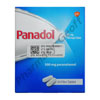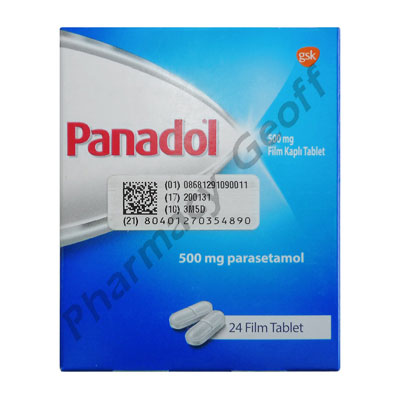| Brand Name: |
Panadol |
| Generic Name: |
Paracetamol |
| Form: |
Tablets |
| Manufacturer: |
GSK |
What is Panadol?
Every Panadol (Paracetamol) - 500mg (24 Tablets) tablet contains 500mg of Paracetamol, the active ingredient of the medication.
Panadol (Paracetamol) is an antipyretic and analgesic agent. Its mechanism of action is based on blocking cyclooxygenase (COX) 1 and 2, primarily in the central division of the nervous system. It affects the centers of the heat regulating and pain centers.
Panadol (Paracetamol) does not produce almost any anti-inflammatory effect. It does not have an irritating effect on the mucous membranes of the digestive system (intestines and stomach). It is unable to affect the process of prostaglandins synthesis in the peripheral tissues and water-salt metabolism.
Panadol (Paracetamol) is used for the symptomatic treatment and management of the pain:
- Menstrual pain
- Muscle pain
- Headaches
- Pain caused by burns
- Toothache
- Migraine
- Post-injury pain
- Back pain
- Sore throat
Panadol (Paracetamol) is prescribed as an antipyretic agent (for fever syndrome) in case of high body temperature (cold, influenza, infection). Please note that it does not affect the progression and the course of the disease and is only administered to reduce the severity of the pain symptoms.
How is Panadol used?
It adults, the standard prescribed dose ranges from 500 to 1000mg and is taken up to 4 times per day if necessary. The recommended time interval between the doses is 4 hours. It is safe to take up to 8 500mg tablets per day. Long-term administration of Panadol (Paracetamol) should not exceed 5 days as an analgesic and 3 days as an antipyretic. The decision to increase the daily dose or the duration of treatment has to be made by your physician.
It is recommended to take Panadol (Paracetamol) in doses, indicated in the package insert. In case higher doses were administered, it is required to seek immediate medical attention even when there are no negative symptoms, as delayed liver damage may develop. In adult patients, first signs of liver damage occur when the administered dose exceeds 10g. Administration of a dose exceeding 5g has a toxic effect in a certain category of patients, who are exposed to the following risk factors:
- Frequent consumption of alcoholic beverages in large quantities
- Concurrent administration of Phenytoin, Phenobarbital, Carbamazepine, Rifampicin, Primidone, St. John's Wort, and other medications stimulating liver enzymes production
- Glutathione deficiency (in patients suffering from HIV, cystic fibrosis, food deficiency, malnutrition, and starvation)
Intoxication symptoms include:
- Excessive sweating
- Abdominal pains
- Pale skin
- Nausea
- Vomiting
Severe poisoning may lead to the acute renal failure, arrythmia, encephalopathy, coma, tubular necrosis, and pancreatitis.
The treatment includes stomach lavage, administration of the enterosorbents (such as Lignin and activated charcoal), administration of the precursors of the glutathione and methionine synthesis and sulfhydryl group donors. When the damage to liver is severe, the treatment is conducted under the guidance of poison control center experts.
Adverse effects
Panadol (Paracetamol) is well tolerated when taken in the recommended doses.
Potential adverse events affecting the urine system may include:
- Interstitial nephritis
- Renal colic
- Renal papillary necrosis
- General bacteriuria
Other side effects may include:
- Anemia
- Neutropenia
- Skin rash
- Angioedema
- Agranulocytosis
- Dyspeptic disorders
- Thrombocytopenia
- Skin itching
- Methemoglobinemia
- Hepatotoxic effects, and liver damage
Warnings
It is recommended to periodically monitor blood values. Panadol (Paracetamol) should be used with caution in patients taking cholesterol-lowering medications (Cholestyramine), antiemetic agents (Domperidone, Metoclopramide) and suffering from kidney or liver disorders.
Panadol (Paracetamol) may not be frequently used in patients taking anticoagulant medications on a daily basis. Notify your physician if you're taking Panadol (Paracetamol) before blood sugar and urine acid levels testing. In the course of treatment with Panadol (Paracetamol), alcoholic beverages must not be consumed. Panadol (Paracetamol) should be prescribed with caution in patients with alcohol addiction.
Panadol (Paracetamol) is counter indicated in patients with hypersensitivity to the active ingredient or other components of the drug. Panadol (Paracetamol) 500mg tablets must not be given to children under the age of 6 years.
Realtive counter indications include:
- Gilbert's syndrome
- Liver failure
- Benign hyperbilirubinemia
- Alcohol-induced liver damage
- Kidney failure
- Pregnancy
- Virus hepatitis
- Elderly age
- Glucose-6-phosphate dehydrogenase deficiency
- Alcohol addiction
- Breastfeeding
|




